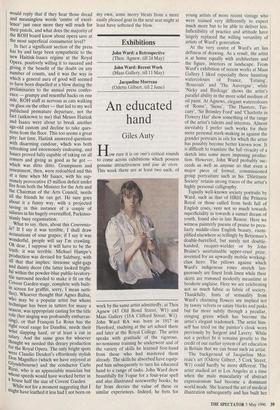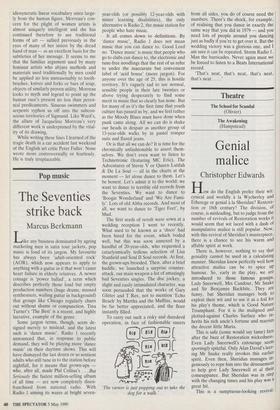Exhibitions
John Ward: a Retrospective (Thos. Agnew, till 24 May) John Ward: Recent Work (Maas Gallery, till 11 May)
An educated hand
Giles Auty
How rare it is on one's critical rounds to come across exhibitions which possess genuine attractiveness and joie de vivre. This week there are at least two such, of work by the same artist admittedly, at Thos Agnew (43 Old Bond Street, W1) and Maas Gallery (15A Clifford Street, W1). John Ward RA was born in 1917 in Hereford, studying at the art school there and later at the Royal College. The artist speaks with gratitude of the rigorous, no-nonsense training he underwent and of the variety of skills he learned first-hand from those who had mastered them already. The skills he absorbed have equip- ped him subsequently to turn his educated hand to a range of tasks. John Ward drew beautifully for Vogue for a four-year spell and also illustrated noteworthy books; he far from decries the value of these or similar experiences. Indeed, he frets for young artists of more recent vintage who were trained very differently to expect much more but to be able to deliver less. Inflexibility of practice and attitude have largely replaced the willing versatility of artists of Ward's generation.
At the very centre of Ward's art lies deftness of drawing. As a result, the artist is at home equally with architecture and the figure, interiors or landscape. From Ward's exhibition of recent works at Maas Gallery I liked especially three haunting watercolours of France, 'Estaing', `Bouzouls' and 'The Auvergne', while Nicky and Birdcage' shows the artist's parallel ability in the more solid medium of oil paint. At Agnews, elegant watercolours of `Rome', 'Siena', 'The Hunters, Tus- cany', `Sir Brinsley Ford' and 'Charlotte in Flowery Hat' show something of the range of the artist's talents and interests. Almost inevitably I prefer such works for their more personal mark-making as against the grander portraits in oils for which the artist has possibly become better known now. It is difficult to translate the full vivacity of a sketch into some more imposing produc- tion. However, John Ward probably suc- ceeds as well as anyone so that even a major piece of formal, commissioned group portraiture such as his 'Dilettante Society' retains strong traces of the artist's highly personal calligraphy.
Equally well-known society portraits by Ward, such as that of HRH the Princess Royal or those culled from beds full of English roses, veer not so much towards superficiality as towards a sunset dream of youth, found also in late Renoir. Here we witness painterly paeans of praise to pecu- liarly middle-class English beauty, exem- plified elsewhere so tellingly by Betjeman's• double-barrelled, but surely not double- handed, racquet-wielder or by John Braine's unattainable upper-crust prize, invented for an upwardly mobile working- class hero. The pillows against which Ward's indigenous roses stretch lan- guorously are finest Irish linen while their skirts are trimmed modestly meantime in broderie anglaise. Here we are celebrating not so much fabric as fabric of society. Thankfully, hints of sensuality from Ward's charming flowers are implied not by tawny velvets or satiny blacks and pinks but far more subtly through a peculiar, stinging green which has become the artist's elegant trademark. The artist him- self has tried on the painter's cloak worn previously by Sargent and Lavery. While not a perfect fit it remains greatly to the credit of our earlier system of art education in Britain that we can boast such an artist.
The background of Jacqueline Mor- reau's art (Odette Gilbert, 5 Cork Street, WI) could hardly be more different. The artist studied art in Los Angeles at a time when the male muscularity of abstract expressionism had become a dominant world mode. She learned the art of medical illustration subsequently and has built her idiosyncratic linear vocabulary since large- ly from the human figure. Morreau's con- cern for the plight of women artists is almost uniquely intelligent and she has continued therefore to use traditional forms of art — sullied previously in the eyes of many of her sisters by the dread hand of man — as an excellent basis for the subtleties of her message. It seems to me that the familiar argument used by many feminist artists who abjure methods and materials used traditionally by men could be applied no less unreasonably to tooth- brushes, knives and forks or bars of soap, objects of similarly proven utility. Morreau looks to myth and legend to point up the human race's present no less than peren- nial predicaments. Sinuous swimmers and serpents syphon us off into the subcon- scious territories of Sigmund. Like Ward's, the allure of Jacqueline Morreau's very different work is underpinned by the vital- ity of its drawing.
While writing these lines I learned of the tragic death in a car accident last weekend of the English art critic Peter Fuller. None wrote more controversially or fearlessly. He is truly irreplaceable.



















































 Previous page
Previous page